Homemade Solid Bar Dish Soap

Making soap is super fun. ‘Making this zero-waste dishwashing bar is even better. This simple ingredient recipe for my Homemade Solid Bar Dish Soap makes fluffy bubbles and cuts grease on pots and pans.
Why Make Dish Soap?
If you make your own dish soap you can reduce the use of plastics. You will also know what you are putting on your hands and dishes. I also like the fact that I can avoid the use of palm oil.
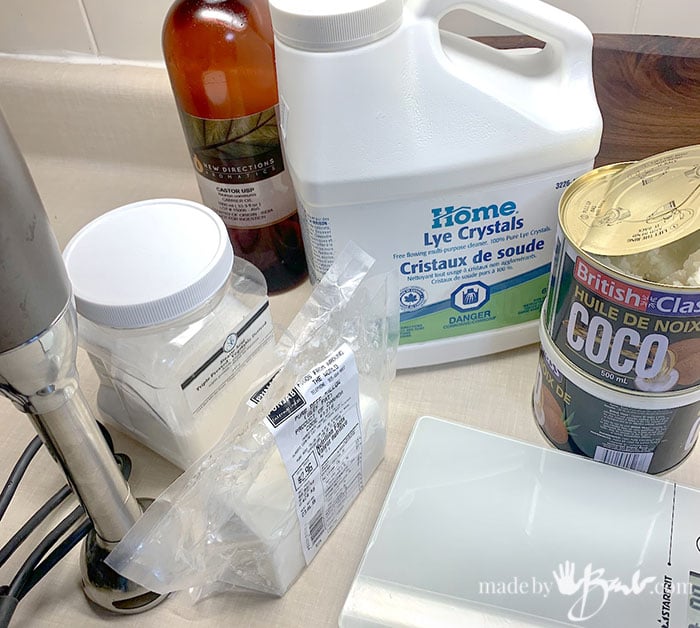
How do you make soap?
This recipe is a cold process soap method; meaning it isn’t a ‘cooked’ hot process soap. If you have never made soap before don’t worry, it really isn’t that scary once you understand the process. My Basic Cold Process soap instructions explains the details of soap making. Soap is created when a reaction (saponification) occurs between a lye/water solution and oils/fats. Depending on your choice of fats/oils will make the type of the soap fit your needs. I buy my lye (sodium hydroxide) at the local hardware store and the other ingredients at the grocery store or a soap supply shop.
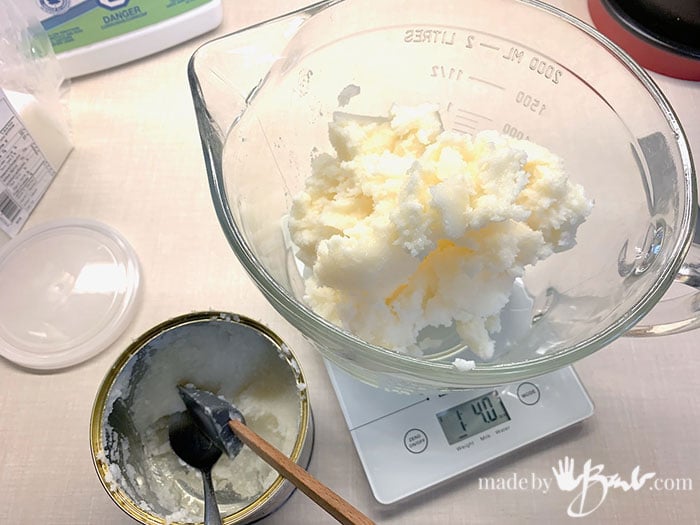
The Recipe for My Homemade Solid Bar Dish Soap:
You can use this Soap Calc to calculate the Lye and give you suggestions for make particular soap recipes.
The Oil/Fats:
- 20 ounces Coconut Oil
- 1 ounce Stearic acid*
- 1 Ounce Castor Oil
- 1.5 Ounces Beef Tallow
The Lye Solution:
- 7.05 ounces water
- 4.15 ounces Lye
(may add optional essential oils or keep fragrance-free)
*If you do not have stearic acid (looks like little beads ) you can omit it but run your recipe through the Soap Calc. This just add a bit of extra hardness to the recipe.
The castor oil helps give the soap bubbles. Tallow also makes a hard soap bar. In the ‘olden days’ every part of the animal was used so they made soap from the leftover fat, rendering it to get all the impurities out.

Notice the ‘Soap Bar Quality’ column; this soap will be very hard, highly cleansing, not conditioning, very bubble, & creamy. Since this is a soap for cleaning I am not having any ‘Superfat’; oils that will not be saponified (notice super fat%).
Soap made with high amounts of coconut oil is quite strong in washing away grease but can also be harsh on your hands. I made a Super Cleanse scrubber bar that was designed for getting my hands clean when DIY’ing.
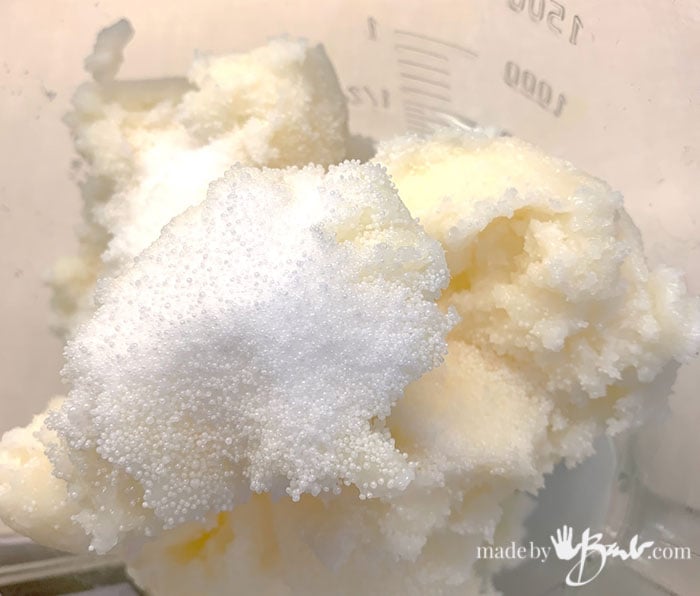
Step #1:
Check out my basic soap-making tutorial here for details AND SAFETY MEASURES.
Measure (weigh) the oils/fats with a good scale. I tare the scale between adding each into the same container. Measure (weigh) the water and Lye. To keep the Lye from getting too hot I place the bowl in an ice water bath (use a well ventilated area or a fanhood for the fumes from the lye). Slowly add the lye to the water, stir and more.

Adding the castor Oil to the oils.
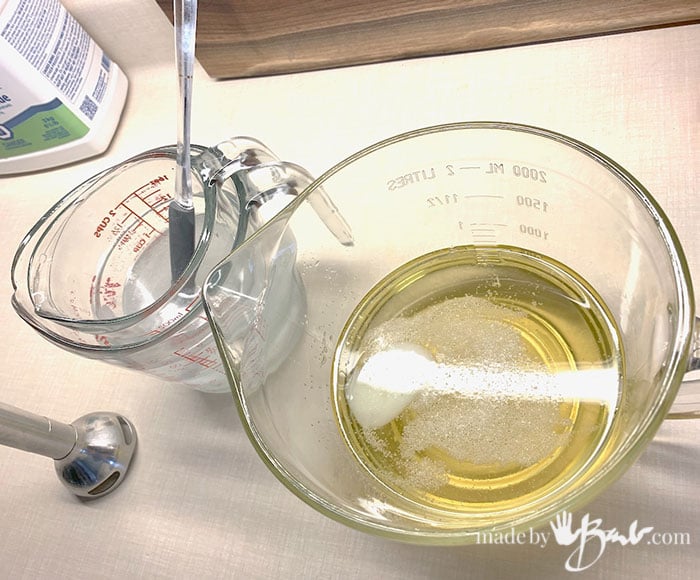
Short bursts in the microwave will melt the oils/fats. The Stearic acid will need a bit more time to melt. The oil/fat mixture will be slightly warm. Ideally the fats and oils should be a similar temperature to the lye solution. Measure the temperature to determine when they are the similar.
Get your soap molds for the bars ready. I used a silicone mold that would make bars to fit into small glass bowls. You can also pour directly into small bowls
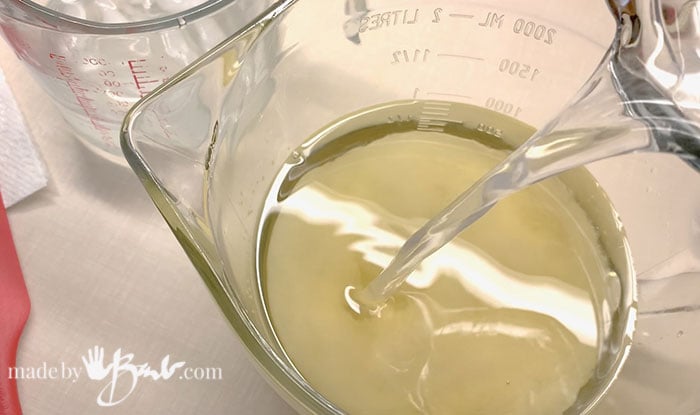
Step #2
When temperatures are right pour the Lye solution (Lye & Water) into the melted oils/fats. The lye will start to react with the oils and fats.

To make the mixing easier use an immersion blender to mix the soap batter. If you desire to add any fragrance or scent you can add some essential oils. Sweet orange or other citrus oil is lovely in these bars.

The Soap batter will start to become thicker and turn into one thick pudding-like liquid. Mix carefully to avoid splashes. When the blender leaves a line in the mix the soap has reached ‘Trace’. That means that it can be poured into the mold.
Step #3:

This dish soap recipe comes to trace very quickly so work fast to get it into the molds.

The Batter has been smoothed into the molds and bowls. They will now be loosely covered witha towel to allow the soap to Gel. The chemical reaction also makes the soap as it saponifying. After a few hours it will cool and become hard. The amount of time will depend on the temperatures in the space.
Step #4:
Once the soap is hard it can be removed from the molds or cut if in a box mold. Soap will cure more over time and get a bit harder as it looses moisture. It should not be in a sealed container.

I have been making soap for almost 10 years and still marvel at how beautiful a fresh white bar looks – maybe because I know I made it! I make some rope bowls to give soaps as well received hostess gifts etc,
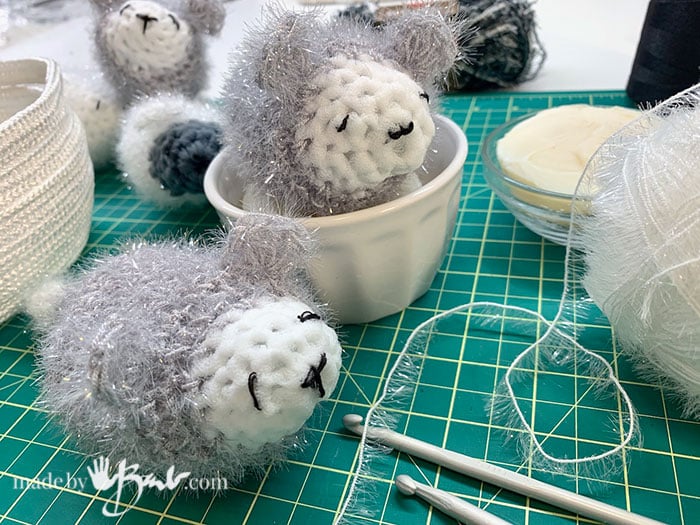
Make Some Scrubbies:
To use these Homemade Solid Bar Dish Soaps a scrubby or brush works well. Crochet a little Scrub buddy out of this special scrubby yarn. Oh, did you know that you can also crochet strips of tulle – so cool!
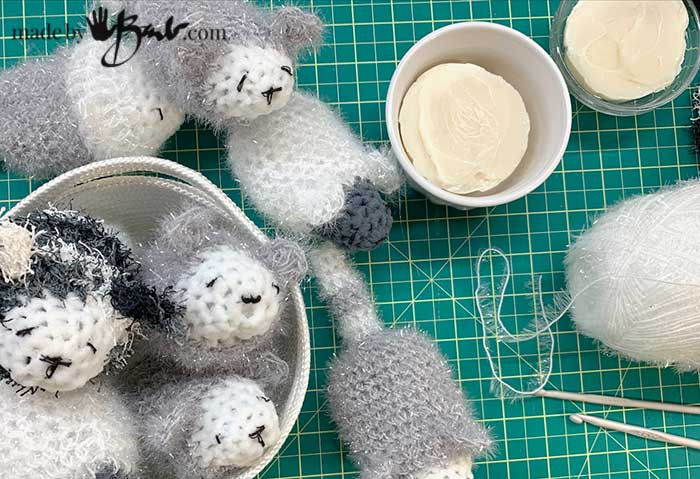
Well, maybe that chore of washing dishes at the sink will be a bit more joyful with these Scrub Buddies!

Wet the scrubby or dishcloth and work up a lather on the soap bar. This eco-friendly solid soap bar becomes bubbly quite easily.

Rinse out the scrubby, shake out excess water and let the solid dish soap bar dry. They work much better than a sponge! Enjoy!
Thanks for this idea. I am soaping myself, but only soaps for us. A dishing soap sounds like a really practical thing to make. As I have lots of bee’s wax I think this will be a good substitute for stearic acid which makes my hands itch. The 0 superfat is super obvious once you’ve been told. And SoapCalc is also my tool of choice for soaping – even though I always check the recipes by hand 😉
Yes, a bit of beeswax can also help harden the bar. I also make the soap for only family and friends. If you sell, you need to follow rules and also have some insurance in case you ever have any customer issues.
Wow! You just continue to amaze me with the things you do, Barb!!! This took me down memory lane. We lived out in “a blink-your-eyes-and you’ll miss it” tiny town out in the sandhills of West Texas when I was young. I remember my mother making lye soap and using lye to make hominy from corn. Also, being told we’d get our mouth washed out with lye soap if we said something ugly. Lol
Your soap bars are gorgeous! And the little sheep scrubby is sooo cute! Don’t know if I’m brave enough to try making the soap, but I know I can make the scrubby. Thanks again for all your creativity you so unselfishly share!🥰🥰
Oh thanks! Making soap was one of the things that started to give me the confidence to do more making projects. Once you are aware of the safety issues, it’s like whipping up a batch of muffins… 😉
Absolutely love this! Do you have instructions for the scrubbies, Barb? Unfortunately, I’m a crochet by the instructions kind of gal. 🙃 Kathy
I could possibly draft up the pattern… stay tuned. You can also crochet 2 circles and single crochet them together. That sparkly yarn is fun to work will and seems to really hold up well for scrubbing and rinse clean easily.
This is a great soap recipe. Never tried tallow in soapmaking…will add it to my list of ingredients to try this year.
Thanks for sharing. 😊💐
If you do’t have access to tallow you can just use the coconut oil. I once made a very high tallow (becomes sodium tallowate) content soap and it was very brittle. Small amounts are nice; it’s even in ‘Dove’ soap, amoungst a lot of other stuff. For body and skin a combination of certain oils will make a nice conditioning bar, especially with some extra super fat. It can become an obsession! One of my true favourite ingredients is actually lard (becomes sodium lardate); as much as it sounds odd, it has a close similarity to human skin; sooooo conditioning… like a lotion.
And now lard too is having a comeback, at least in Australia. I always thought it must be highly comedogenic, but no.
I’ve never made soap before and have wanted to try dish soap. Can you tell me what I can substitute to make it completely vegetarian? Thanks, Barb~
The stearic acid may be derived from animal or vegetable sources, so checking with the manufacturer would be best. You could leave it out. The coconut and castor oil are fine. Some recipes do add an acid to work with hard water, however changing the chemistry of the soap recipe may also effect the Lye as it is an alkali. Soap Calc does not have an input for adding an acid. I would first make a small simple recipe: (I’ve put it through Soap Calc): I hope that helps. It may be drying to the hands; if you are sensitive wear gloves.
I hope that helps. It may be drying to the hands; if you are sensitive wear gloves.